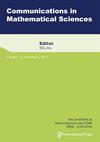Implicit-explicit Runge-Kutta methods for Landau-Lifshitz equation with arbitrary damping
IF 1.3
4区 数学
Q2 MATHEMATICS, APPLIED
引用次数: 0
Abstract
Magnetization dynamics in ferromagnetic materials is modeled by the Landau-Lifshitz (LL) equation, a nonlinear system of partial differential equations. Among the numerical approaches, semi-implicit schemes are widely used in the micromagnetics simulation, due to a nice compromise between accuracy and efficiency. At each time step, only a linear system needs to be solved and a projection is then applied to preserve the length of magnetization. However, this linear system contains variable coefficients and a non-symmetric structure, and thus an efficient linear solver is highly desired. If the damping parameter becomes large, it has been realized that efficient solvers are only available to a linear system with constant, symmetric, and positive definite (SPD) structure. In this work, based on the implicit-explicit Runge-Kutta (IMEX-RK) time discretization, we introduce an artificial damping term, which is treated implicitly. The remaining terms are treated explicitly. This strategy leads to a semi-implicit scheme with the following properties: (1) only a few linear systems with constant and SPD structure needs to be solved at each time step; (2) it works for the LL equation with arbitrary damping parameter; (3) high-order accuracy can be obtained with high-order IMEX-RK time discretization. Numerically, second-order and third-order IMEX-RK methods are designed in both the 1-D and 3-D domains. A comparison with the backward differentiation formula scheme is undertaken, in terms of accuracy and efficiency. The robustness of both numerical methods is tested on the first benchmark problem from National Institute of Standards and Technology. The linearized stability estimate and optimal rate convergence analysis are provided for an alternate IMEX-RK2 numerical scheme as well.具有任意阻尼的 Landau-Lifshitz 方程的隐含-显式 Runge-Kutta 方法
铁磁材料中的磁化动态是由 Landau-Lifshitz (LL) 方程建模的,这是一个非线性偏微分方程系统。在各种数值方法中,半隐式方案因其在精度和效率之间的良好折衷而被广泛应用于微磁学模拟。在每个时间步长上,只需要求解一个线性系统,然后应用投影来保持磁化长度。然而,该线性系统包含可变系数和非对称结构,因此非常需要高效的线性求解器。如果阻尼参数变大,人们已经意识到,只有具有恒定、对称和正定(SPD)结构的线性系统才有高效的求解器。在这项工作中,基于隐式-显式 Runge-Kutta (IMEX-RK) 时间离散化,我们引入了一个人工阻尼项,并对其进行了隐式处理。其余项则采用显式处理。这种策略导致半隐式方案具有以下特性:(1) 每个时间步只需求解几个具有常数和 SPD 结构的线性系统;(2) 它适用于具有任意阻尼参数的 LL 方程;(3) 通过高阶 IMEX-RK 时间离散化可以获得高阶精度。在数值上,设计了一维和三维领域的二阶和三阶 IMEX-RK 方法。在精度和效率方面,与后向微分公式方案进行了比较。在美国国家标准与技术研究院的第一个基准问题上,对两种数值方法的稳健性进行了测试。此外,还为另一种 IMEX-RK2 数值方案提供了线性化稳定性估计和最佳速率收敛分析。
本文章由计算机程序翻译,如有差异,请以英文原文为准。
求助全文
约1分钟内获得全文
求助全文
来源期刊
CiteScore
1.70
自引率
10.00%
发文量
59
审稿时长
6 months
期刊介绍:
Covers modern applied mathematics in the fields of modeling, applied and stochastic analyses and numerical computations—on problems that arise in physical, biological, engineering, and financial applications. The journal publishes high-quality, original research articles, reviews, and expository papers.

 求助内容:
求助内容: 应助结果提醒方式:
应助结果提醒方式:


